
 Walking around the site of the Civil War prison at Andersonville, one can’t help but envision the horrid conditions of more than 30,000 men crammed into a 26-acre pen left mostly to fend for themselves against the environment, hunger and rampant sickness. Andersonville serves as a somber reminder of one of the most grim aspects of war, prisoners of war or “POW”s. This site honors not only POWs of the Civil War but all wars, and while it’s a sobering place, it’s definitely worth a visit.
Walking around the site of the Civil War prison at Andersonville, one can’t help but envision the horrid conditions of more than 30,000 men crammed into a 26-acre pen left mostly to fend for themselves against the environment, hunger and rampant sickness. Andersonville serves as a somber reminder of one of the most grim aspects of war, prisoners of war or “POW”s. This site honors not only POWs of the Civil War but all wars, and while it’s a sobering place, it’s definitely worth a visit.
Visitor Rating (write your own review below)
Sobering Place
ILNP Park Review
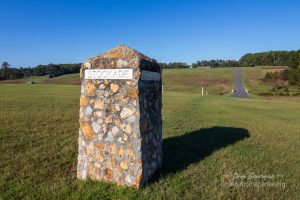
The line of the old prison stockade is marked with white stakes for both the wall and the “deadline”, and each of the corners is marked with a stone monument such as this one at the southeast corner
Our Visit I visited Andersonville in early November while on a trip to Warner Robins, Georgia.
Our Weather A beautiful 75 degrees and sunny
About the Park Andersonville National Historic Site, Georgia, was established in 1970 to manage the site of the most notorious prison of the American Civil War (Camp Sumpter) where more than 13,000 Union prisoners died in just over a year. In addition to the prison site, the park also houses the National POW Museum and the Andersonville National Cemetery.
 Visiting Andersonville is an easy place to visit, but you’ve got to be looking for it. There are no major towns nearby, and it’s only accessed by driving two-lane roads through the peaceful woods and fields of southwestern Georgia. It’s a small park, so two hours is sufficient time to visit the three main portions of the park: the prison site, the National POW Museum, and the Andersonville National Cemetery. If you’re pressed for time, an hour will still allow you to take a quick drive around the prison and a digest version of the POW Museum.
Visiting Andersonville is an easy place to visit, but you’ve got to be looking for it. There are no major towns nearby, and it’s only accessed by driving two-lane roads through the peaceful woods and fields of southwestern Georgia. It’s a small park, so two hours is sufficient time to visit the three main portions of the park: the prison site, the National POW Museum, and the Andersonville National Cemetery. If you’re pressed for time, an hour will still allow you to take a quick drive around the prison and a digest version of the POW Museum.
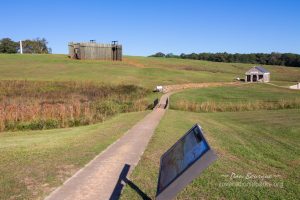
The prison site is easily accessed via short trails like this one from the road–this shows Providence Spring and the rebuilt North Gate
The first stop should be the Visitors Center where you can pick up a brochure with a map of the site and an audio tour guide if you’re so inclined (you can also download it from the NPS website). I recommend touring the Prison Site first. The audio tour is set up for driving which most visitors do. It’s a series of about half a dozen stops and very short hikes along the road that circles the prison. I chose to walk which was an easy 1-mile hike. As you work your way counter-clockwise around the prison, you’ll see monuments erected by the states whose men died here, the old earthworks and some restored cannon on the outside of the prison, and two sections of rebuilt stockade. Along the way are plenty of signs, pictures and diagrams to help you understand what life was like here during the Civil War. Another feature is the series of white stakes that mark the site of the old stockade wall and the “deadline” (area within the wall where prisoners would be shot if they strayed) allowing you to picture the prison.
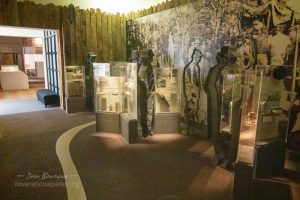
The National POW Museum is full of all kinds of sobering and thought-provoking exhibits covering POWs throughout history
After returning to the Visitors Center, take some time to tour the small but excellent National POW Museum. This museum covers POWs throughout history and does an excellent job of illustrating conditions, the feelings of the prisoners and their families, and the legal struggles with prisoners throughout the history of warfare.
If you have an extra 20-30 minutes, I recommend visiting the Andersonville National Cemetery, just a few minutes’ drive from the Visitors Center. The first gravestones you’ll see are those of the Union soldiers first buried here. As many as 100 a day died here and were buried tightly packed in long trenches. Only the diligent work of prisoner Dorence Atwater, detailed to the hospital, preserved the names of the prisoners and where they were buried, allowing these headstones to mark the graves for families and friends. The northern section of the cemetery is still active and more closely resembles other national cemeteries.
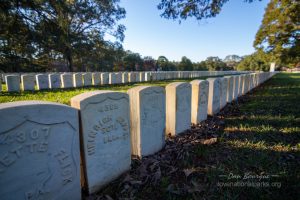
The first graves in Andersonville National Cemetery are those of the Union prisoners who died at the prison. They were laid side by side in long trenches, hence the tight headstones.
Suggestions If you visit in the summer, prepare for the heat–there is very little shade in the prison site. If you bring children, I recommend discussing the somber nature of this place beforehand. While the green fields may beckon them to run and play, recreation is not allowed at the prison site, and the park rules urge you to keep voices lowered.
Nearby Towns Oglethorpe, Montezuma, Macon, Columbus, Albany (Georgia)
Other Nearby Attractions Jimmy Carter National Historic Site
Official Website Andersonville National Historic Site
- The large Visitors Center for Andersonville is also home to the National POW Museum
- The National POW Museum is full of all kinds of sobering and thought-provoking exhibits covering POWs throughout history
- This memorial to POWs stands just outside the museum next to the prison site
- The prison was surrounded by a series of earthwork defenses like this one near the visitors center
- The northwest corner of the prison is full of 11 different monuments erected by states who’s prisoners were held captive at Andersonville–this is the largest, built by Wisconsin
- The North Gate is one of two rebuilt sections of the stockage–this was what it looked like for prisoners entering Andersonville minus the tens of thousands of prisoners
- Providence Spring, now covered by this monument, opened up while the prisoners were still captive giving them a source of much-needed fresh water
- Star Fort sits at the southwest corner of the prison and was home to the headquarters
- The prison site is easily accessed via short trails like this one from the road–this shows Providence Spring and the rebuilt North Gate
- This shows the overall layout of the prison looking northeast from the southwest corner–in the middle is the low area of Stockade Branch, a stream that flowed through the prison
- The line of the old prison stockade is marked with white stakes for both the wall and the “deadline”, and each of the corners is marked with a stone monument such as this one at the southeast corner
- There are two reconstructed sections of the prison–this is the northeast corner showing one of the “pigeon roosts” used to keep watch over the prisoners
- The prisoners at Andersonville had to make their own shelters out of old blankets, clothing and sticks–they called them “shebangs”
- The first graves in Andersonville National Cemetery are those of the Union prisoners who died at the prison. They were laid side by side in long trenches, hence the tight headstones.
- The more recent additions to Andersonville National Cemetery follow the more traditional spacing of national cemeteries
Write Your Own Review

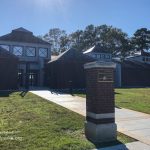
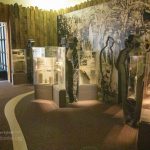

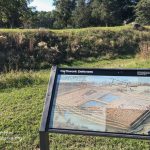
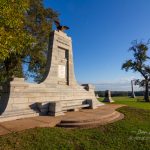



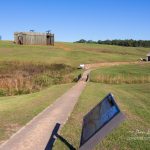
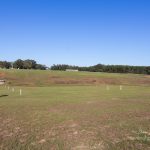
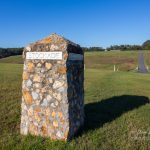
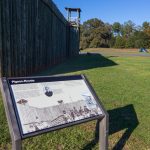

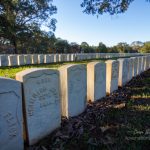

No Comments Yet